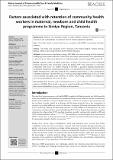| dc.contributor.author | Ngilangwa, David P. | |
| dc.contributor.author | Mgomella, George S. | |
| dc.date.accessioned | 2022-08-20T08:58:20Z | |
| dc.date.available | 2022-08-20T08:58:20Z | |
| dc.date.issued | 2018-08-02 | |
| dc.identifier.citation | Ngilangwa DP, Mgomella, GS. Factors associated with retention of community health workers in maternal, newborn and child health programme in Simiyu Region, Tanzania. Afr J Prm Health Care Fam Med. 2018;10(1), a1506. https://doi.org/ 10.4102/phcfm.v10i1.1506 | en_US |
| dc.identifier.issn | Online: 2071-2936, | |
| dc.identifier.issn | Print: 2071-2928 | |
| dc.identifier.uri | https://repository.amref.ac.ke/handle/123456789/777 | |
| dc.description | Copyright:
© 2018. The Authors.
Licensee: AOSIS. This work
is licensed under the
Creative Commons
Attribution License | en_US |
| dc.description.abstract | Abstract
Attrition of community health workers (CHWs) continues to threaten the full realisation and sustainability of community-based health programmes globally. Aim: This study aimed to understand factors associated with CHWs' recruitment and their retention. Setting: This study was conducted in five districts of the Simiyu Region, namely, Bariadi, Busega, Itilima, Maswa and Meatu in north-western Tanzania. Methods: In this cross-sectional study design, 341 CHWs who were working with the maternal health programme were randomly selected. Semi-structured questionnaires were administered to all participants. Data were descriptively and inferentially analysed using SPSS version 20. Results: Majority (58.0%) of CHWs were below 35 years. Over half (53.1%) had completed primary education only. Motivation factors for being CHW were aspiration to serve the community and desire for further training to become a qualified medical practitioner. Community recognition and financial incentives were among the key retention reasons for the CHWs. Being married (odds ratio [OR] 5.9, 95% confidence interval [CI] 1.7-20.1) having prior volunteer experience (OR 10.5 95% CI 12.7-40.5) and prior employment OR 21.8 (CI 12.2-38.9) were positively associated with retention of CHWs, while being a female was negatively associated with retention OR 0.4 (CI 0.2-0.8). Conclusions: Both financial and non-financial incentives were critical in contributing to the retention of CHWs. Thus, health programmes should carefully select CHWs by understanding their motives beforehand, and provide them with incentives. | en_US |
| dc.description.sponsorship | Canadian Department of Foreign Affairs and Trade (DFATD) formerly Canadian International Development Agency (CIDA) through the Uzazi Uzima programme | en_US |
| dc.language.iso | en | en_US |
| dc.publisher | AOSIS | en_US |
| dc.subject | Community health workers (CHWs) | en_US |
| dc.subject | Tanzania | en_US |
| dc.subject | Attrition | en_US |
| dc.subject | Maternal | en_US |
| dc.subject | Recruitment | en_US |
| dc.title | Factors Associated with Retention of Community Health Workers in Maternal, Newborn and Child Health Programme in Simiyu Region, Tanzania | en_US |
| dc.type | Article, Journal | en_US |

